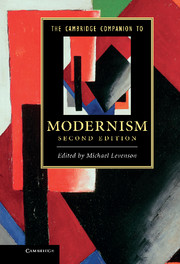Book contents
- Frontmatter
- Introduction
- 1 The metaphysics of Modernism
- 2 The cultural economy of Modernism
- 3 The Modernist novel
- 4 Modern poetry
- 5 Modernism in drama
- 6 Modernism and the politics of culture
- 7 Modernism and religion
- 8 Modernism and mass culture
- 9 Modernism and gender
- 10 Musical motives in Modernism
- 11 Modernism and the visual arts
- 12 Modernism and film
- 13 Modernism and colonialism
- Further reading
- Index
10 - Musical motives in Modernism
Published online by Cambridge University Press: 28 September 2011
- Frontmatter
- Introduction
- 1 The metaphysics of Modernism
- 2 The cultural economy of Modernism
- 3 The Modernist novel
- 4 Modern poetry
- 5 Modernism in drama
- 6 Modernism and the politics of culture
- 7 Modernism and religion
- 8 Modernism and mass culture
- 9 Modernism and gender
- 10 Musical motives in Modernism
- 11 Modernism and the visual arts
- 12 Modernism and film
- 13 Modernism and colonialism
- Further reading
- Index
Summary
A scientific event removed one of the most important obstacles from my path. This was the further division of the atom. The collapse of the atom was equated, in my soul, with the collapse of the whole world. Suddenly,the stoutest walls crumbled. Everything became uncertain, precarious and insubstantial. I would not have been surprised had a stone dissolved into thin air before my eyes and become invisible.
There is nothing more enabling or more disabling than total lack of support: you fall or you fly. The artists of the beginning of the twentieth century found themselves in a state of uncomfortable freedom; and if no one would legislate for them, they had to make their own laws. The painter Vassili Kandinsky, one of the founders of abstract painting (and the author of the epigraph above), was fond of citing the Dostoevskian phrase "Everything is permitted" - he felt that, when the discipline of the representable form has vanished, painters have to seek discipline elsewhere. Again and again Kandinsky fretted about a lack of grammar in the art of painting, and envied the art of music for having a set of reliable procedures, "its own grammar, which, like all living things, changes."
- Type
- Chapter
- Information
- The Cambridge Companion to Modernism , pp. 232 - 244Publisher: Cambridge University PressPrint publication year: 2011



